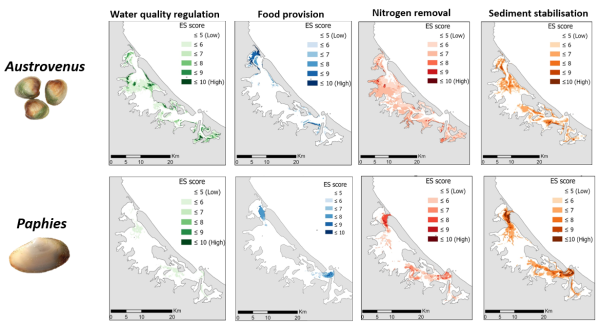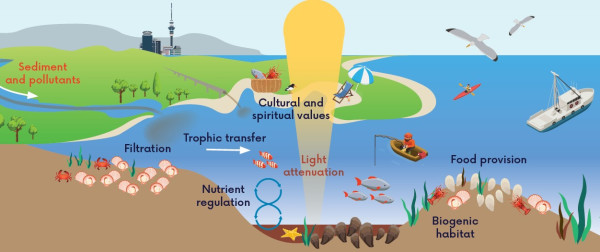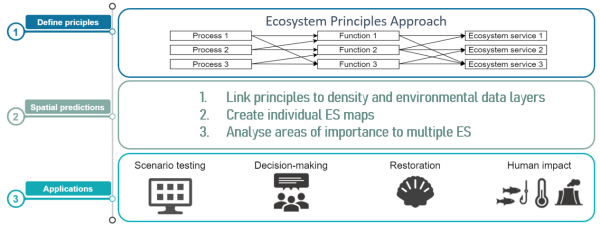- Guidance
Ecosystem service mapping in marine environments: a case study
This guidance explains what ecosystem service mapping is, and why it is useful for marine managers, planners, and other decision-makers. It provides a case study to demonstrate ecosystem service mapping in Tauranga Harbour. Rullens V (October 2022)
Overview
In marine environments, a multitude of goods and services are generated that provide benefits and value to people.
These ecosystem services (ES) connect what the ecosystem does (ecological processes and functions) to the things that people care about.
Improving our understanding of how and where services are being generated and might interact with each other, provides insights into which areas are of highest importance.
This information is critical for making decisions on how to manage ecosystem services and move towards more sustainable management that will protect those benefits and values for future generations.
Figure 1: Shellfish provide a wide range of ecosystem services (ES) beyond the provision of food
Benefits of using ES mapping:
It is difficult to safeguard ES until we know where they are being generated, in what quantity, and how they interact with each other. By quantifying and mapping ES, we can get insights into the areas of importance for ES delivery. This provides a ‘piece to the puzzle’ for managers, allowing them to make informed decisions and better assess the costs and benefits of management actions
Challenges to ES mapping:
- Marine environments are data limited, but tools to generate ES maps often require large amount of (spatial) data and are complex
- ES quantification can favour ES that can be expressed easily, often in monetary value ($$), over those with social or ecological immaterial benefits (eg biodiversity conservation, cultural heritage, recreational value)
Solutions:
- Use existing ecological knowledge to identify where ES can be generated through first-order ‘principles’
- Principle based approach can be applied in low data environments and provides a first assessment of areas of importance
- Approach can be applied to a wide range of ES and does not favour those with market (monetary) value
Case study: Shellfish Ecosystem Services in Tauranga Harbour
Figure 2: Ecosystem principles approach overview
1) Ecological principles
Principles are generalised and simplified representations of the ecological role shellfish play in service provision derived from scientific literature. Each principle is linked to an aligned data layer which is used to convert the principle to a spatial map, with different scores depending on the shellfish density or environmental conditions in each cell. The ES score is calculated by multiplying the score for each principle by a weighting based on the principle’s importance, and adding these scores together.
| Principal description | Weighting | Aligned data |
| ES1 Food provision | ||
| P1.1 Large bivalves are more desirable for consumption, hence for sites with high densities of large individuals, service value will be higher | 5x | Density of large individuals |
|
P1.2 Easily accessible locations provide higher service potential, which is reduced if more effort is required to access the shellfish bed. Locations within walking distance and on the intertidal/shallow subtidal are scored higher |
3x | Distance to access point and bathymetry |
| P1.3 High contamination levels can render shellfish less desirable or unsuitable for consumption and can decrease food provision potential in contaminated sites. | 2x | Sediment heavy metal levels |
2.) Ecosystem services mapping
The contribution of two ecologically and culturally important shellfish (cockles and pipi) to the provision of four ES were mapped for Tauranga Harbour.
The ES studied considered a range of contributions including shellfish contribution to:
- water quality regulation
- food provision
- nitrogen removal
- sediment stabilisation
Maps show that the location of importance for ES and the amount provided are species-specific and vary with local environmental conditions. High-density areas are important, but maps show that not all dense shellfish beds contribute to the same services.
This information will allow managers to set conservation and management priorities based on more than species' densities alone. A targeted management approach that includes environmental context contributes to sustainable provision of ES for the future.
Figure 3: ES maps for cockles (Austrovenus; top row) and pipi (Paphies; bottom row) ES potential in Tauranga harbour (Rullens et al. 2022) 
3) Applications
- Scenario testing: assessing how ES may change with a certain activity (eg reclamations or development of marinas) and test multiple scenarios to find the best option
- Decision making: providing a ‘piece to the puzzle’ for managers to make informed decision and assess cost and benefits of management actions
- Restoration: finding the best location to increase ES by restoring a shellfish bed
- Measuring human impacts: predicting how human impacts (eg fishing, climate change, pollution) may degrade ES in the future
Social and cultural values
Cultural and social values tend to be overlooked or underrepresented in decision making because they are context specific (dependent on identity, ethnicity, religion, etc) and difficult to measure. Methods used to identify, assess and value ecological processes and functions (as used in this study) are not the same as those used for assessing cultural and social values. This gap can be addressed by combining ecological knowledge with mātauranga Māori and social science.
Related resources:
- Using ecosystem service bundles to improve marine management
- The Challenge of Implementing the Marine Ecosystem Service Concept
- Who is contributing where? Predicting ecosystem service multifunctionality for shellfish species through ecological principles

